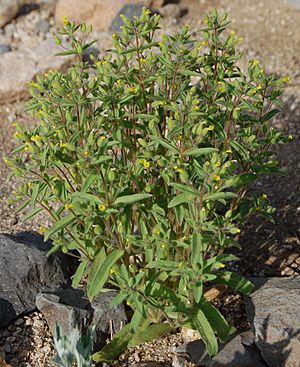Erythranthe pilosus facts for kids
Quick facts for kids Erythranthe pilosus |
|
|---|---|
 |
|
| Scientific classification | |
| Kingdom: | |
| (unranked): | |
| (unranked): | |
| (unranked): | |
| Order: | |
| Family: |
Phrymaceae
|
| Genus: |
Mimetanthe
|
| Species: |
M. pilosa
|
| Binomial name | |
| Mimetanthe pilosa Greene
|
|
Mimetanthe pilosa is a special kind of plant often called the false monkeyflower or downy mimetanthe. It grows naturally in the western parts of the United States and in Baja California, Mexico. You can usually find it in places that are wet or have been disturbed, like roadsides.
This plant is quite unique. It's so different from other monkeyflowers that scientists sometimes place it in its own special group, called Mimetanthe. Other times, it's still kept with the Mimulus group. It used to be known by the name Mimulus pilosus.
About the Downy Mimetanthe
The downy mimetanthe is an annual plant. This means it grows, flowers, and produces seeds all in one year, then dies. It can grow up to about 35 centimeters tall, which is roughly the length of a standard ruler.
What it Looks Like
This plant is covered in many long hairs, making it feel fuzzy or "downy." Its leaves grow in pairs, one on each side of the stem. They are shaped like a spearhead, either narrow or wide, and are usually about 1 to 3 centimeters long.
The flowers of the false monkeyflower are quite small. The bottom part of each flower is shaped like a tube. This tube is protected by a cup-like structure made of small leaf-like parts called sepals. The yellow flower itself is less than a centimeter long. It has five round parts at its opening, and you can often see small red dots inside its throat.

